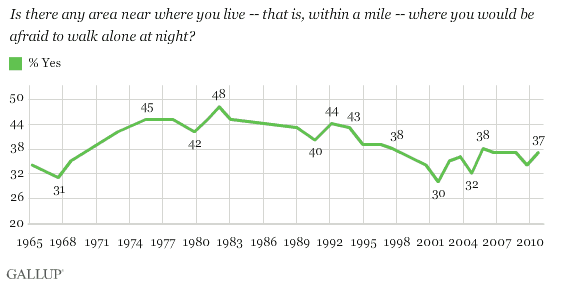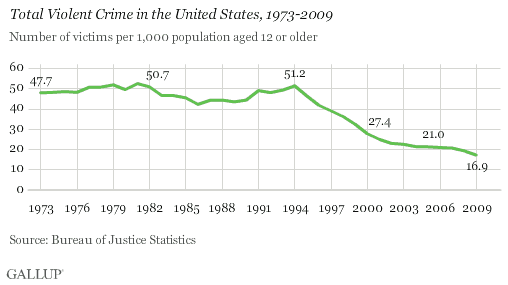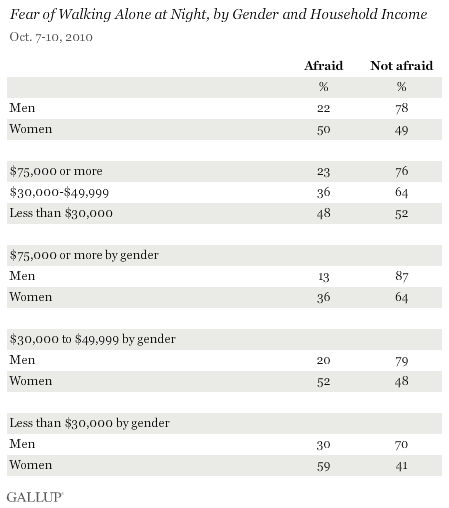PRINCETON, NJ -- Nearly 4 in 10 Americans, 37%, say they would be afraid to walk alone at night within a mile of their home. That is close to the average level of fear on this measure across the 35-year Gallup trend.

The latest results are from Gallup's annual Crime survey, conducted Oct. 7-10, 2010.
According to the trend, the highest level of public fear about being victimized when walking alone at night was recorded in 1982. At that time, nearly half of adults, 48%, said they were afraid, while 52% were not afraid.
Fear stayed fairly high through 1993, registering above 40%, but then descended to 30% by 2001. It has since increased slightly, although it has not returned to the record-high levels.
This trend in Americans' perceptions of their personal safety contrasts with federal crime statistics showing a sharp, steady decline in the rate of violent crime (including murder, rape, robbery, aggravated assault, and simple assault) over the past 16 years. After two decades when violent crime registered at or near 50 victims per 1,000 population, crime plummeted during the 1990s and 2000s, and is now at its lowest level in recent history.

Fear Varies by Gender, Income
Americans' fear of crime victimization relates strongly to two distinct factors: household income and gender. Adults living in low-income households are roughly twice as likely as those living in high-income households to be afraid, 48% vs. 23%.
Women are more than twice as likely as men to say they are afraid to walk alone at night near their home, 50% vs. 22%. This 28-point gender gap conforms to what Gallup found on this issue globally in 2009 with a different question asked in 105 countries.
Additionally, women are more fearful than men at every income level. This confirms that the higher fear among women is not solely a function of their somewhat lower socioeconomic status compared with that of men.

There are only slight regional differences in attitudes about personal safety from crime, with residents of the Midwest a bit less likely to be afraid to walk alone at night near their home than are those in the other three regions. Thirty percent in the Midwest are afraid, compared with 38% in the East, South, and West combined.
From a political standpoint, it is interesting to note that Democrats are more likely to be concerned about their safety locally than are Republicans (46% vs. 32%); that could have implications for the anti-crime policies supported by each party. However, in contrast to the differences by gender, that fear gap is largely erased when household income is controlled for.
Bottom Line
The proportion of Americans afraid to venture out alone at night near their home is lower today than at points in the past, when the crime rate was significantly higher than it is today -- such as in 1982 and 1993. However, it has not decreased as sharply as the drop in violent crime over the past decade. In fact, while the violent crime rate has dropped steadily each year and now stands at a record low, the percentage afraid to walk alone at night has rebounded somewhat, suggesting fear of crime is not necessarily dictated by reality. The degree to which media portrayals of crime factors into these perceptions, and how aware Americans are of the declining crime rate, is unclear.
Results for this Gallup poll are based on telephone interviews conducted Oct. 7-10, 2010, with a random sample of 1,025 adults, aged 18 and older, living in the continental U.S., selected using random-digit-dial sampling.
For results based on the total sample of national adults, one can say with 95% confidence that the maximum margin of sampling error is ±4 percentage points.
Interviews are conducted with respondents on landline telephones (for respondents with a landline telephone) and cellular phones (for respondents who are cell phone-only). Each sample includes a minimum quota of 150 cell phone-only respondents and 850 landline respondents, with additional minimum quotas among landline respondents for gender within region. Landline respondents are chosen at random within each household on the basis of which member had the most recent birthday.
Samples are weighted by gender, age, race, education, region, and phone lines. Demographic weighting targets are based on the March 2009 Current Population Survey figures for the aged 18 and older non-institutionalized population living in continental U.S. telephone households. All reported margins of sampling error include the computed design effects for weighting and sample design.
In addition to sampling error, question wording and practical difficulties in conducting surveys can introduce error or bias into the findings of public opinion polls.
View methodology, full question results, and trend data.
For more details on Gallup's polling methodology, visit https://www.gallup.com/.
